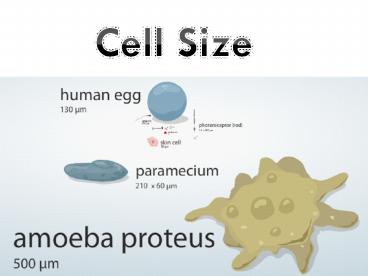Cell%20Size - PowerPoint PPT Presentation
Title:
Cell%20Size
Description:
Why are Cells Small? cells must exchange nutrients & other molecules with their environment food must come in and wastes go out the cell membrane is the only way in ... – PowerPoint PPT presentation
Number of Views:151
Avg rating:3.0/5.0
Title: Cell%20Size
1
Cell Size
2
Why are Cells Small?
- cells must exchange nutrients other molecules
with their environment - food must come in and wastes go out
- the cell membrane is the only way in and out of
the cytoplasm - the cell membrane has a limited surface area
- the cytoplasm has a volume to feed or have
wastes removed
3
Surface area of a cell
- If it were a perfect square, how would you
calculate surface area? - Each side is 1 x 11unit squared, 6 sides
therefore, surface area 6 units squared
Distance equals on unit
4
Volume of a cell - cytoplasm
Distance equals one unit
- Volume equals Length x Width x Height
- Thus the volume equals 1 x 1 x 1
- Volume equals 1 unit cubed
5
(No Transcript)
6
Comparison of Size, Surface Area Volume
Cell size Surface area (units2) Volume (units3) Ratio of SA/V
1 unit 6 1 6/1
2 units 24 8 24/8 3/1
3 units 54 27 54/27 2/1
7
Conclusion
- As cell size increases ratio of surface area to
volume decreases. - Therefore, the rate of diffusion slows down.
- ..thus a cell cannot get rid of wastes fast
enough or get nutrients fast enough - . . . so it will either be poisoned by its wastes
or starve.
8
Surface Area to Volume
- Cell surface area is important in taking in
nutrients - Surface area increases as the square of cell
diameter - But entire cell volume needs to be fed
- And, cell volume increases as the cube of cell
diameter so it increases at a faster rate
9
Consider 2 Cells...
100 µm diameter
10 µm diameter
10
Surface Area to Volume
11
(No Transcript)
12
(No Transcript)
13
Cell types
14
Prokaryotes vs. eukaryotes
- All living cells can be divided into two major
types - Prokaryotes simple cells that lack a nucleus,
always single-celled - Eukaryotes complex cells with a distinct
nucleus, can be single-celled or multicellular
15
Prokaryotic cells
- lack a nuclear membrane the DNA floats freely
in the cytoplasm - lack any membrane-bound organelles (like
mitochondria)
16
Plant vs. animal cells
- Within eukaryotes, there are two major kinds of
cells - Plant cells stiff cell wall gives the cell
shape, large vacuoles, special organelles called
chloroplasts - Animal cells lack cell walls and chloroplasts,
vacuoles are small, centrioles are visible
17
What they have in common
- both have a cell membrane
- both have a nucleus with DNA inside
- both have many of the common organelles (ER,
Golgi complex, etc.) - both have mitochondria for making energy
18
Common structures in plant and animal cells
19
Organelles found in plant cells
- Cell wall made of cellulose, gives cell
strength and protection - Larger vacuoles store water and keep cell rigid
- Chloroplasts make sugar from CO2 and sunlight -
photosynthesis
20
Organelles found in animal cells
- Centrioles attachment for the cytoskeleton,
organise spindle fibres during cell division
21
Plant Cells Animal cells
Have a cell wall Do not have a cell wall
Have chloroplasts Do not have chloroplasts
Have large vacuoles Have small vacuoles
No visible centrioles Centrioles visible
22
(No Transcript)
23
Some exceptions to this!
- Protist cells
- single-celled eukaryotes (protists) can have
organelles typical of both plant AND animal cells - Fungus cells
- multicellular eukaryotes with a cell wall made of
chitin (the same substance in the exoskeleton of
insects) - cell walls can remain open after cell division,
and the cells are free to move back and forth































